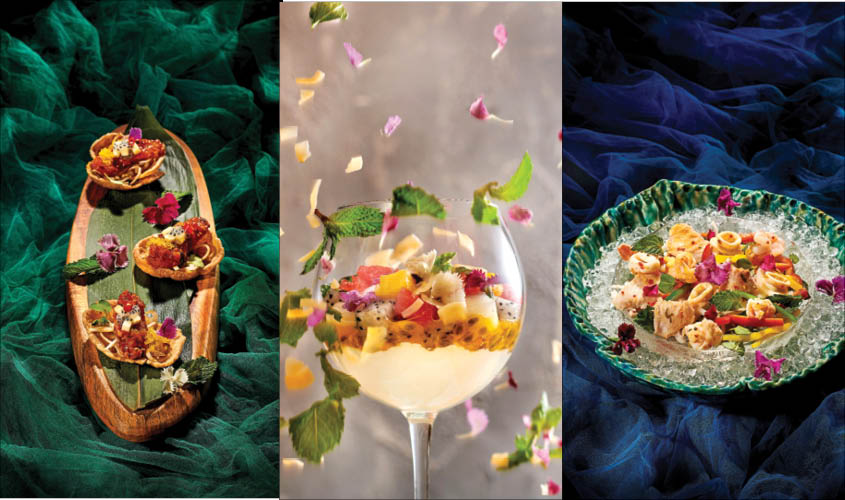Vietnamese food can be expounded as aromatic and spicy but with a subtlety that is likable. It has contrasting flavours, implying that the dishes will usually have a combination of sweet and sour, hot and cool, cooked and raw or crispy and smooth flavours.
Vietnamese cuisine is popular for its fish sauce, soy sauce, rice, fresh fruits and vegetables, herbs and spices including lemongrass, lime, kaffir lime leaves. Throughout Vietnam, people emphasise on serving fresh vegetables and herbs as accompaniments to the dips or sauces. Pork, chicken, shrimp, cockles and seafood are the habitually used forms of meat in Vietnamese cuisine. Beef is often used for making Pho Soup and the “seven-course beef” dish—both popular delicacies in this cuisine.
Unlike Indian cuisine, Vietnamese food is not heavy and loaded with spices. It is influenced by other cuisines like French (due to colonisation) and Chinese (for being its neighbouring culture). Hence the authenticity and uniqueness of Vietnamese cuisine are unmatched. While their stews have French influence, the use of varied sauces is a clear Chinese touch. The accumulative result is usually a burst of sweet, spicy, salty and sour flavours that can be felt in their rice noodle soups (Pho), steamed rice paper rolls (Bánh Cuon), sandwiches (Bánh Mì), steamed rice cakes (Bánh) and sago puddings (Chè Tự Chọn).
While the cuisine must be a perfect blend of fresh vegetables, oil and dairy, chefs in India have improvised the dishes using more of the known ingredients—like potato, raw mango, jaggery, tamarind and fish—to achieve more acceptance and appreciation for the foreign
While southern Vietnamese dishes are spicier, sweeter and oilier, and are served with more exotic fruits and vegetables, northern Vietnamese dishes are influenced by French and Chinese cooking styles.
There are certain characteristics that I have observed and liked about this cuisine. One that is worth mentioning is that the food is mostly served fresh. The meat is briefly cooked and vegetables are consumed fresh or boiled or briefly stir-fried. All the dishes are prepared in huge amounts of vegetables and herbs. Most of the condiments served along with the main dish are colourful and arranged in a pleasing manner.
As an entrepreneur, I have always wanted to come up with characteristic restaurants or cafés and when I tasted Vietnamese food for the first time in Germany, I knew that this is what I wanted to bring back to India with me. After my other ventures, I wanted to foray into the space of premium dining through specialised cuisine that brings selected favourites from the vibrant Vietnam, by offering quintessential dishes made from ingredients as ordinary as fish sauce, sugar and rice. Though the flavours of Vietnamese cuisine are unique, they are very adaptable and go well with the Indian palate. The people of Delhi of late have been quite inclined towards Asian cuisines and it is my belief that Vietnamese food will soon be in demand.
My main motivation behind bringing Vietnamese cuisine to Delhi via Viet Nom, India’s first authentic Veitnamese restaurant, was to popularise the food and fill in some major voids in Delhi’s F&B scene. The capital city does not have multiple options when it comes to Vietnamese cuisine. The rich cultural journey of Vietnam from pre-historic times to the present day has critically influenced the palate of its people. And we have tried to pour that nostalgia of traditional dishes into every aspect—sight, smell and savour—of this delectable cuisine in our menu.
While pork and beef are popular in Vietnamese cuisine, we have designed the menu using more chicken, as that’s the meat preferred by Delhi diners. I believe improvisation comes hand-in-hand when you are introducing anything new. So we have curated the recipes to match Indian taste buds, while using all the ingredients from Vietnam. The humble Hoi An Rice cooked in chicken broth and served with shredded chicken, fresh herbs, pickles and a chilli sauce, the Stone Hot Pot Fish which is created in front of our guests and the Lolot, are some of our showstoppers.
My aim was to showcase the different flavours of Vietnamese food with high quality ingredients and to make a difference in how Vietnamese food is perceived by Indian diners.
The author is a restaurateur who owns Masakali, Pink Room, Molecule, The Drunken Botanist and Viet Nom in Delhi-NCR

